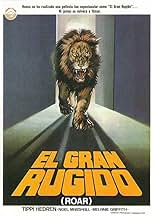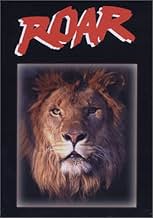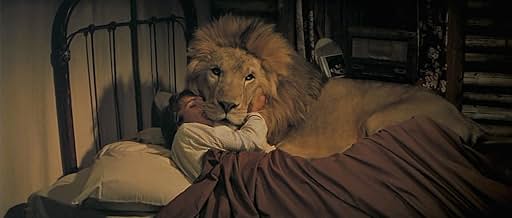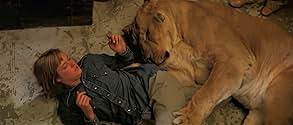AVALIAÇÃO DA IMDb
6,1/10
5 mil
SUA AVALIAÇÃO
Um naturalista que vive com grandes felinos na África Oriental espera a visita de sua família de quatro pessoas de Chicago. Uma confusão o deixa em busca de sua família, que foi deixada nas ... Ler tudoUm naturalista que vive com grandes felinos na África Oriental espera a visita de sua família de quatro pessoas de Chicago. Uma confusão o deixa em busca de sua família, que foi deixada nas mãos de leões selvagens.Um naturalista que vive com grandes felinos na África Oriental espera a visita de sua família de quatro pessoas de Chicago. Uma confusão o deixa em busca de sua família, que foi deixada nas mãos de leões selvagens.
- Direção
- Roteiristas
- Artistas
Zakes Mokae
- Committee Member
- (as Zakes Moakae)
- Direção
- Roteiristas
- Elenco e equipe completos
- Produção, bilheteria e muito mais no IMDbPro
Avaliações em destaque
I first saw this in the early 90s on a vhs. Revisited it recently with my 7 year old nephew.
While i found it a bit tedious now, my nephew enjoyed it.
The film doesn't have any plot n it has lots of hide n seek kinda moments. It is funny at times, the scene where the lioness try the skateboard, the facial expression of the big cat when a leopard grabs away the meal, the cat pushing the female in the water, etc.
The film is very picturesque.
I found Tippi Hedren at 51 in this film very attractive n in good shape.
ROAR is one of those rare films where the behind-the-scenes story is more interesting than the one up on screen. It's a would-be animal movie along the lines of BORN FREE about a normal American family coping with a house full of big cats, but the whole thing is so ridiculous in both execution and planning that it's a film which has gained infamy as one of the most dangerous in history.
The problem lies with writer/director/star Noel Marshall, he of the wild hair and dubious acting talents. Marshall thought it would be a good idea to mix together a ton of different big cats, including a number of male lions, and throw them in with unprepared actors, including his wife Tippi Hedren and stepdaughter Melanie Griffiths. The resulting shooting schedule saw over 70 injuries to cast and crew, the most infamous of which was the director of photography, Jan De Bont, getting scalped.
The enjoyment factor of this one is of the 'car crash' variety. Marshall is obviously a zealot who acts and sounds a lot like Timothy Treadwell, the doomed star of the Herzog documentary GRIZZLY MAN, who got a bit too close to the grizzly bears he was obsessed with and paid with his life. Nobody died during ROAR, but they came close. There isn't really a script here, just characters reacting to the big cats, and the only decent bit is the tense mid-section in which Hedren and her screen children attempt to evade the cats which are chasing them around the house (which is far better than the whole of the tiger-in-the-house thriller BURNING BRIGHT). Otherwise, it's just a case of watch and endure it.
The problem lies with writer/director/star Noel Marshall, he of the wild hair and dubious acting talents. Marshall thought it would be a good idea to mix together a ton of different big cats, including a number of male lions, and throw them in with unprepared actors, including his wife Tippi Hedren and stepdaughter Melanie Griffiths. The resulting shooting schedule saw over 70 injuries to cast and crew, the most infamous of which was the director of photography, Jan De Bont, getting scalped.
The enjoyment factor of this one is of the 'car crash' variety. Marshall is obviously a zealot who acts and sounds a lot like Timothy Treadwell, the doomed star of the Herzog documentary GRIZZLY MAN, who got a bit too close to the grizzly bears he was obsessed with and paid with his life. Nobody died during ROAR, but they came close. There isn't really a script here, just characters reacting to the big cats, and the only decent bit is the tense mid-section in which Hedren and her screen children attempt to evade the cats which are chasing them around the house (which is far better than the whole of the tiger-in-the-house thriller BURNING BRIGHT). Otherwise, it's just a case of watch and endure it.
Noel Marshall and Tippi Hedren certainly had a, uh, interesting relationship for a while there in the 70's and early 80's. I don't know what their marriage was like behind closed doors of course, but somehow it's a great gift to the Earth that they produced the film ROAR. Why this is can't be easily explained in a review, but I can try with this: it's about a family that lives with lions and tigers and some elephants and panthers too. Or rather it's about a guy who LOVES these lions and tigers (by the way, why tigers, shouldn't they be in India and, oh, nevermind) and panthers and so on, and invites his wife to come live with him along with her and his kids. So here comes Tippi Hedren and actual real life children Melanie Griffith and John and Jerry (Marshall's kids), and when they arrive Noel is out uh doing stuff out in the plains or jungle, and they have to contend with a house full of lions. Oh, and these were UNTRAINED LIONS by the way.
In a way I should be critical of Roar. Marshall, with the exception of one sequence that takes on the qualities of a Night of the Living Dead picture with wild cats in place of the un-dead, doesn't really set up suspense very well. The fascination with watching Roar is basic but constant: these are real people, many of them likely not exactly used to the f***ing idea of hanging out with things like lions and tigers, being knocked around, chased, bombarded by their paws and jaws and bodies, and that should in all likelihood they could/should kill these people.
There's also the behind the scenes drama that imbues real danger with what's on screen so much; right on the cover of the blu-ray it states that 70 cast/crew were harmed, and looking up who got what is just staggering (to give you an idea of the extent, director of photography Jan de Bont got his skull practically knocked off, and Melanie Griffith got facial reconstructive surgery, though the fact that we didn't notice in those movies she starred in in the 80's shows how good that surgery must have been). If there was a documentary on the making of this film it might make Herzog's Grizzly Man look like kids stuff.
Indeed the hero to me of this film is de Bont; he gets his camera into places that I just couldn't think would be possible, right in the faces of these lions, capturing action that seems impossible - certainly with the knowledge that these lions didn't have proper, you know, TRAINERS. It's just a feeling of constant WTF that goes on with this - likely why it got picked up by Drafthouse Films as Drafthouse CEO Tim League is all about finding the freshest and brightest of those WHAT IS THIS sort of flick (they also released Miami Connection some years back) - and it's amazing just on that basis alone. It's also just hysterically funny in that way that the movie lacks that awareness of the danger. Or, let me rephrase that, I think the director knew that there would be danger with these cats, but, well, why carp? The attitude is that Man is the biggest enemy - the closest thing to antagonists are under-developed hunters, you know they are as they get lines showing that I guess and they have the guns - and that, with the exception of one memorable/super-bloody lion named Togar, the lions would be just peaceful and lovable creatures if left alone.
But the ethos of the filmmakers is constantly at odds with what IS shown on screen. The actors, to their credit (at least Hedren and Griffith to an extent), get this and play this fear well through a long mid-section. There's really the feeling like there isn't really any, shall we say, 'acting' going on here; to this end, Melanie is named Melanie as are the Marshall sons, though why Hedren is a different character name is anyone's guess. I'd be surprised if there even was a solid script - how do you get these lions et al to do the things they do? It's an entirely maddening enterprise to see unfold, the kind of movie that shouldn't have been made, and may even be (borderline?) unethical, but as it is here you can't look away from the metaphorical train-wreck.
In a way I should be critical of Roar. Marshall, with the exception of one sequence that takes on the qualities of a Night of the Living Dead picture with wild cats in place of the un-dead, doesn't really set up suspense very well. The fascination with watching Roar is basic but constant: these are real people, many of them likely not exactly used to the f***ing idea of hanging out with things like lions and tigers, being knocked around, chased, bombarded by their paws and jaws and bodies, and that should in all likelihood they could/should kill these people.
There's also the behind the scenes drama that imbues real danger with what's on screen so much; right on the cover of the blu-ray it states that 70 cast/crew were harmed, and looking up who got what is just staggering (to give you an idea of the extent, director of photography Jan de Bont got his skull practically knocked off, and Melanie Griffith got facial reconstructive surgery, though the fact that we didn't notice in those movies she starred in in the 80's shows how good that surgery must have been). If there was a documentary on the making of this film it might make Herzog's Grizzly Man look like kids stuff.
Indeed the hero to me of this film is de Bont; he gets his camera into places that I just couldn't think would be possible, right in the faces of these lions, capturing action that seems impossible - certainly with the knowledge that these lions didn't have proper, you know, TRAINERS. It's just a feeling of constant WTF that goes on with this - likely why it got picked up by Drafthouse Films as Drafthouse CEO Tim League is all about finding the freshest and brightest of those WHAT IS THIS sort of flick (they also released Miami Connection some years back) - and it's amazing just on that basis alone. It's also just hysterically funny in that way that the movie lacks that awareness of the danger. Or, let me rephrase that, I think the director knew that there would be danger with these cats, but, well, why carp? The attitude is that Man is the biggest enemy - the closest thing to antagonists are under-developed hunters, you know they are as they get lines showing that I guess and they have the guns - and that, with the exception of one memorable/super-bloody lion named Togar, the lions would be just peaceful and lovable creatures if left alone.
But the ethos of the filmmakers is constantly at odds with what IS shown on screen. The actors, to their credit (at least Hedren and Griffith to an extent), get this and play this fear well through a long mid-section. There's really the feeling like there isn't really any, shall we say, 'acting' going on here; to this end, Melanie is named Melanie as are the Marshall sons, though why Hedren is a different character name is anyone's guess. I'd be surprised if there even was a solid script - how do you get these lions et al to do the things they do? It's an entirely maddening enterprise to see unfold, the kind of movie that shouldn't have been made, and may even be (borderline?) unethical, but as it is here you can't look away from the metaphorical train-wreck.
You know what? Sometimes words really aren't enough to do justice to something.
Roar has to be without a doubt the most insanely unsafe cinematic undertaking I have ever had the pleasure of watching. The unbelievably high level of danger is quite frankly there for everyone to see up on the screen as we watch a group of actors interact with over one hundred big cats with no protection whatsoever! It was inspired by the success of the lion drama Born Free (1966). And you might make the observation that there is fifteen years between these two movies and think this strange, well that's because this flick took eleven years from start to finish! Its production met with all manner of set-backs such as fire, flood and disease; each of which put the film's schedule back. But more to the point, it was as dangerous to work on as it looks on screen. The opening credits state that no animals were hurt in the making of the film, what they could not say with as much confidence was that there were no humans hurt! As it was, seventy cast and crew were injured, including cinematographer Jan de Bont who was partially scalped, Tippi Hedren had her neck bitten, Melanie Griffiths almost lost an eye, Jerry and John Marshall both required extensive stitches, while Noel Marshall was attacked so often it took years for him to recover from his injuries. When you watch Noel in action in this film it is not exactly hard to see why! In fact some of the injuries can be seen happening on screen. It is madness, pure and utter madness.
But because of this, it makes for highly entertaining and bizarre viewing. Unfortunately, the public back in 1981 didn't seem to agree and Roar was a box office disaster. To be honest, this is not entirely surprising as this feels far more like a cult movie than blockbuster material, given its utter strangeness. For a start it doesn't really have a plot and it boils down to a few events that bring our human cast into contact with the big cats. The story barely makes sense if you think about it very long. But who needs a story when you've got this insanity on screen? The madness and health and safety black hole that the events on screen represent mean that a story needs be no more than an afterthought. For what it's worth, Noel Marshall - wrote, starred, directed and financed it and his wife Tippi Hedren, who was a wildlife activist who campaigned for the protection of big cats, was the big name draw. Hedren, of course, was previously most well-known for her starring role in The Birds (1963) where she was famously mauled and scratched by an assortment of flying fiends. Well, all I can say is that what she experiences on Roar makes the actions of the birds in Alfred Hitchcock's classic seem positively reticent by comparison.
The actors are all splendidly game and deserve huge amounts of credit for their nerve but the real stars of Roar are the big cats and rampaging elephants. This is the ultimate wet dream for any lover of the big cats in particular and we have the very strange scenario of seeing lions, cheetahs, panthers, leopards and tigers interacting with each other. Watching them violently wrestle is a pretty nerve shredding thing, except if you are Noel Marshall that is, he usually runs in to join them! But on the whole, while there are a few continuity errors and the editing is full-on and sporadic, this is exciting stuff that could never in a million years be described as boring. It truly defines the term 'one of a kind'. With health and safety legislation what it is now, there is no way in hell there will ever be another film like Roar. It's truly unique and I sure lapped it up.
Roar has to be without a doubt the most insanely unsafe cinematic undertaking I have ever had the pleasure of watching. The unbelievably high level of danger is quite frankly there for everyone to see up on the screen as we watch a group of actors interact with over one hundred big cats with no protection whatsoever! It was inspired by the success of the lion drama Born Free (1966). And you might make the observation that there is fifteen years between these two movies and think this strange, well that's because this flick took eleven years from start to finish! Its production met with all manner of set-backs such as fire, flood and disease; each of which put the film's schedule back. But more to the point, it was as dangerous to work on as it looks on screen. The opening credits state that no animals were hurt in the making of the film, what they could not say with as much confidence was that there were no humans hurt! As it was, seventy cast and crew were injured, including cinematographer Jan de Bont who was partially scalped, Tippi Hedren had her neck bitten, Melanie Griffiths almost lost an eye, Jerry and John Marshall both required extensive stitches, while Noel Marshall was attacked so often it took years for him to recover from his injuries. When you watch Noel in action in this film it is not exactly hard to see why! In fact some of the injuries can be seen happening on screen. It is madness, pure and utter madness.
But because of this, it makes for highly entertaining and bizarre viewing. Unfortunately, the public back in 1981 didn't seem to agree and Roar was a box office disaster. To be honest, this is not entirely surprising as this feels far more like a cult movie than blockbuster material, given its utter strangeness. For a start it doesn't really have a plot and it boils down to a few events that bring our human cast into contact with the big cats. The story barely makes sense if you think about it very long. But who needs a story when you've got this insanity on screen? The madness and health and safety black hole that the events on screen represent mean that a story needs be no more than an afterthought. For what it's worth, Noel Marshall - wrote, starred, directed and financed it and his wife Tippi Hedren, who was a wildlife activist who campaigned for the protection of big cats, was the big name draw. Hedren, of course, was previously most well-known for her starring role in The Birds (1963) where she was famously mauled and scratched by an assortment of flying fiends. Well, all I can say is that what she experiences on Roar makes the actions of the birds in Alfred Hitchcock's classic seem positively reticent by comparison.
The actors are all splendidly game and deserve huge amounts of credit for their nerve but the real stars of Roar are the big cats and rampaging elephants. This is the ultimate wet dream for any lover of the big cats in particular and we have the very strange scenario of seeing lions, cheetahs, panthers, leopards and tigers interacting with each other. Watching them violently wrestle is a pretty nerve shredding thing, except if you are Noel Marshall that is, he usually runs in to join them! But on the whole, while there are a few continuity errors and the editing is full-on and sporadic, this is exciting stuff that could never in a million years be described as boring. It truly defines the term 'one of a kind'. With health and safety legislation what it is now, there is no way in hell there will ever be another film like Roar. It's truly unique and I sure lapped it up.
And I thought Grizzly Man was crazy. This film made me uncomfortable, bewildered, and astonished all at once. How nobody died during the making of this is beyond me. How ANYBODY in their right mind would even think of committing to this movie for even a fraction of a year is completely and totally insane. For a film with overtones of slapstick comedy, it certainly manages to deliver a feeling of intensity and uneasiness that I've never experienced while watching a movie before. At times, I felt like the novelty was fading away, only to be reminded that THIS FILM IS WHAT HAVING A DEATH WISH LOOKS LIKE. Every so often, you come across a movie that sticks with you for whatever reason. This is one that you won't forget anytime soon. I promise you.
Você sabia?
- CuriosidadesMost of the lion attacks were real, and usually resulted in actual injury to the cast and crew.
- Erros de gravaçãoAfter Hank goes to the airport to get his family, on his return trip, he picks up Mativo and the tigers. Mativo's bike is placed in the trunk with the front wheel hanging out. Further down the road, the trunk is closed with no bike hanging out. Still further, the bike is again hanging out.
- Cenas durante ou pós-créditosOpening credits features this text: "Since the choice was made to use untrained animals and since for the most part they chose to do as they wished, it's only fair they share the writing and directing credits."
- Versões alternativasIn Australia, two versions of the film were shown theatrically. In 1982, a year after the original film received an NRC (PG equivalent) rating, the film was re-released in an edited G-rated version advertised as being "for the whole family".
- ConexõesFeatured in The Making of Roar (2004)
Principais escolhas
Faça login para avaliar e ver a lista de recomendações personalizadas
Detalhes
- Data de lançamento
- País de origem
- Central de atendimento oficial
- Idioma
- Também conhecido como
- El gran rugido
- Locações de filme
- Shambala Preserve, 6867 Soledad Canyon, Acton, Califórnia, EUA(Chief location)
- Empresas de produção
- Consulte mais créditos da empresa na IMDbPro
Bilheteria
- Orçamento
- US$ 17.000.000 (estimativa)
- Faturamento bruto nos EUA e Canadá
- US$ 110.048
- Fim de semana de estreia nos EUA e Canadá
- US$ 15.064
- 19 de abr. de 2015
- Faturamento bruto mundial
- US$ 110.449
- Tempo de duração1 hora 35 minutos
- Cor
- Mixagem de som
- Proporção
- 2.39 : 1
Contribua para esta página
Sugerir uma alteração ou adicionar conteúdo ausente




























